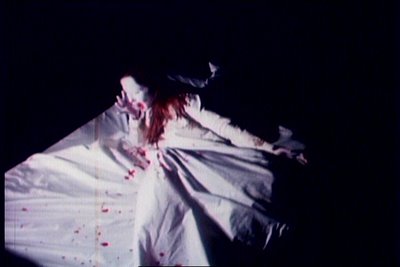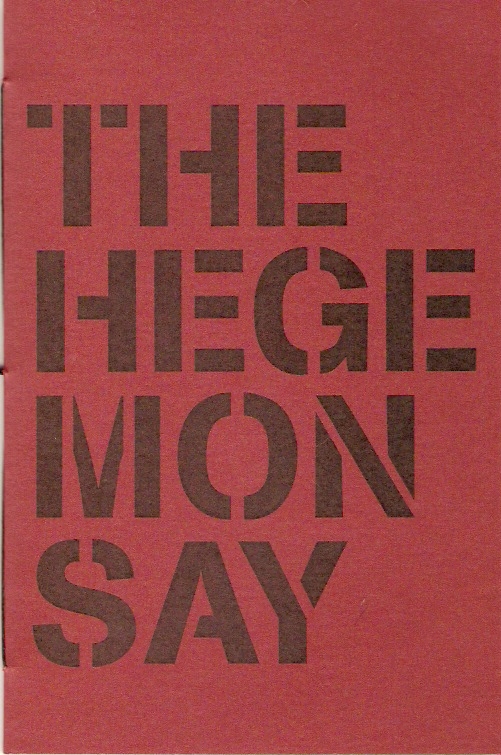
3. Paradisical Dissociations, Literal Hallucinations
After rewatching David Lynch’s films and reading Michel Chion’s generous monograph on the filmmaker, I came up with the following propositions concerning *paradisical language*:
*The erasure of names approaches paradise where a name once was and in its place inheres the trace of a separation resonant with the name’s destruction. This resonance tantamount to a silence beyond silence evokes a condition of word and thing in their purest separation. The signs of paradise remain not only in polesemy or parapraxis, but in a total dissociation of sign and referent. The mind cleaves the body as the person reads or hears words in dissociated states. These words mark a caesura between figural and literal language, the psychotic radiances of literal hallucination versus received reading practices.*
 In David Lynch’s 2002 work, *Rabbits*, a series of actors dressed in rabbit costumes (Naomi Watts, Laura Elena Harring, and Scott Coffey) enter and reenter the set through a door at the set’s left side, and engage in semi-sensical dialogues complete with a situation comedy laugh-track. As in Samuel Beckett’s plays, the psuedo-dialogues of the rabbits would seem to draw attention to an alienation of beings struggling to communicate with one another in a world where meaning making has become difficult, if not impossible. But then I wonder if Lynch really shares Beckett’s problem of communicability? Does the problem of communication in Rabbits not derive instead from the monologues of the separate rabbits being “out-of-synch” temporally (and therefore ontologically) with one another? The lines of *Rabbits'* characters are blocked as if to be spoken to the other characters, yet would appear dictated by conversations occulted from the space in which they take place. We may have a similar sense of this dissociation in the many Lynch characters who would seem to speak in withdrawn states, and, perhaps most memorably, in Rebecca Del Rio’s *Mulholland Drive* cameo when the pop-singer collapses on stage leaving her “pre-recorded” voice to continue singing an emotional, Spanish version of Roy Orbison’s *Crying*. As in the recent work of the artist Catherine Sullivan (*The Chittendens*, 2005)[1], Lynch also establishes a cinematic stage upon which actors reenact traumatic events surpassing the strict purview of a chronological and unified universe. Notwithstanding the filmmaker’s interests in local color, highway journeys and “folk” speech, Lynch may, in fact, be most American where he attends what the poet William Carlos Williams called “the pure products of America”: the hysteric, schizo and psychotic. Like the one hypnotized or in trance, the psychotic tunes-in to the literal fact of words, and in doing so attends a fundamental strangeness of naming language. Through such attentions, the psychotic-hyponotized is admitted to a paradisical condition, if only through the side-door; that is, she is not returned to an Edenic state before naming language so much as she strikes beyond language’s arbitrariness to an objectivity which both grounds words and make them ecstatically obsolete.
In David Lynch’s 2002 work, *Rabbits*, a series of actors dressed in rabbit costumes (Naomi Watts, Laura Elena Harring, and Scott Coffey) enter and reenter the set through a door at the set’s left side, and engage in semi-sensical dialogues complete with a situation comedy laugh-track. As in Samuel Beckett’s plays, the psuedo-dialogues of the rabbits would seem to draw attention to an alienation of beings struggling to communicate with one another in a world where meaning making has become difficult, if not impossible. But then I wonder if Lynch really shares Beckett’s problem of communicability? Does the problem of communication in Rabbits not derive instead from the monologues of the separate rabbits being “out-of-synch” temporally (and therefore ontologically) with one another? The lines of *Rabbits'* characters are blocked as if to be spoken to the other characters, yet would appear dictated by conversations occulted from the space in which they take place. We may have a similar sense of this dissociation in the many Lynch characters who would seem to speak in withdrawn states, and, perhaps most memorably, in Rebecca Del Rio’s *Mulholland Drive* cameo when the pop-singer collapses on stage leaving her “pre-recorded” voice to continue singing an emotional, Spanish version of Roy Orbison’s *Crying*. As in the recent work of the artist Catherine Sullivan (*The Chittendens*, 2005)[1], Lynch also establishes a cinematic stage upon which actors reenact traumatic events surpassing the strict purview of a chronological and unified universe. Notwithstanding the filmmaker’s interests in local color, highway journeys and “folk” speech, Lynch may, in fact, be most American where he attends what the poet William Carlos Williams called “the pure products of America”: the hysteric, schizo and psychotic. Like the one hypnotized or in trance, the psychotic tunes-in to the literal fact of words, and in doing so attends a fundamental strangeness of naming language. Through such attentions, the psychotic-hyponotized is admitted to a paradisical condition, if only through the side-door; that is, she is not returned to an Edenic state before naming language so much as she strikes beyond language’s arbitrariness to an objectivity which both grounds words and make them ecstatically obsolete. After Rene Magritte’s *This is Not a Pipe*, Michel Foucault has demonstrated the calligraphic qualities of Magritte’s art: “Pursuing its quarry by two paths, the calligram sets the most perfect trap. By its double function, it guarantees capture, as neither discourse alone nor a pure drawing could do. It banishes the invincible absence that defeats words, imposing upon them, by the ruses of a writing at play in space, the visible form of their referent. Cleverly arranged on a sheet of paper, signs invoke the very thing of which they speak—from outside, by the margin they outline, by the emergence of their mass on the blank space of the page. And in return, visible form is excavated, furrowed by words that work at it from within, and which, dismissing the immobile, ambiguous, nameless presence, spin forth the web of significations that christen it, determine it, fit it in the universe of discourse. A double trap, unavoidable snare: How henceforth would escape the flight of birds, the transitory form of flowers, the falling rain? (*This Is Not a Pipe*, 22)” Beyond calligraphic ambiguity, do not works like Magritte’s *This is Not a Pipe* and *The Key to Dreams* also evidence a condition of the “distracted”(Jalal Toufic): those who hear to see the literal senses of words inasmuch as they are enduring trance, hypnosis, fugue states, or “undeath”? This is not a pipe because the word “this” can no longer refer to “pipe,” nor the word “pipe” to its image or reality; this is also not a pipe as words roam deictically between the captions of illustrative drawings marking dissociations of names and things named (*The Key to Dreams*). A person experiencing such dissociations may no longer be able to assign the name ‘dead flies’ to the objects they have used as material for their paintings ("In an interview in 1992 by Michel Denisot on the French cable station Canal+ for the release of *Fire Walk With Me*, Lynch was asked about his taste for textures and materials, including things which are considered compulsive, like the series of dead flies he used in compositions. He answered that it is the name we give, the associated word ('dead flies'), which prevents our seeing them as beautiful, and that all we have to do to see differently is to erase the word.”)[2]; the same person may also not be able to assign the proper names of colors to colored shapes when promted by a computer, as in the case of a recent study of hypnotic brain patterns by neuroscientists.[3]
In these paradises of linguistic dissociation we perhaps see words as Louis Zukofsky did after the dream of Shakespeare’s Bottom: as the literal hallucination of written characters witnessed in synaesthetic negation: “The eye of man hath not heard, the ear of man hath not seen, man’s hand is not able to taste, his tongue to conceive, nor his heart report what my dream was.(*Midsummer Night's Dream*, 4.1)” At a limit of paronomasiac language one confronts the pun, a language phenomenon preoccupying both Zukofsky and Lynch. While Zukofsky’s most paronomasiac works may be his homophonic co-translation of Catullus’ Greek with his wife Celia Thaew, and his densely intertextual *80 Flowers*, we may discover Lynch’s most telling use of a pun in the title of his first feature film, *Eraserhead*, where Jack Nance’s eraser-like head detaches from his body to become a template for the production of pencil eraser tips (i.e. eraser heads) on an assembly line.
 Curiously, in Lynch’s second short film, *The Alphabet*, and in his textual paintings, letters assume a similar “dream life” severing the figural and literal. In both cases, this severance involves a misspelling whereby one *mis*-spells not because they lack the memory and attention required to spell properly, but rather because they see too much how letters arbitrarily assign sense (and, in this sense, misspelling or orthographic play may represent an under- or an over- compensation for the failure of letters to live up to the abundance of meaning the paranoid seer reads “into” them). When the girl of *The Alphabet* (Peggy Lynch) coughs–up blood while intermittently spelling the English alphabet, she may seek to purge herself of lexical order so as to produce new associations of letters made dislexic. Paradise lurks in this alchemical activity which pursues a boundary of literal and figural bodies. Parousias of paronomasia, paramnesia, and parapraxis. Paradises of cause, effect, and sense.
Curiously, in Lynch’s second short film, *The Alphabet*, and in his textual paintings, letters assume a similar “dream life” severing the figural and literal. In both cases, this severance involves a misspelling whereby one *mis*-spells not because they lack the memory and attention required to spell properly, but rather because they see too much how letters arbitrarily assign sense (and, in this sense, misspelling or orthographic play may represent an under- or an over- compensation for the failure of letters to live up to the abundance of meaning the paranoid seer reads “into” them). When the girl of *The Alphabet* (Peggy Lynch) coughs–up blood while intermittently spelling the English alphabet, she may seek to purge herself of lexical order so as to produce new associations of letters made dislexic. Paradise lurks in this alchemical activity which pursues a boundary of literal and figural bodies. Parousias of paronomasia, paramnesia, and parapraxis. Paradises of cause, effect, and sense.1. see the February, 2006 issue of Artforum for Sullivan on performativity and historical trauma in *The Chittendens*:
2. p. 173. Chion, Michel. David Lynch. London, BFI 1995.
3. Blakeslee, Sandra. "This is Your Brain Under Hypnosis". New York Times, November 22, 2005.
*The following is part of a longer work I have been writing for the upcoming issue of Crayon, on "beauty". Thanks to Crayon co-editor Andrew Levy for the invitation!














No comments:
Post a Comment